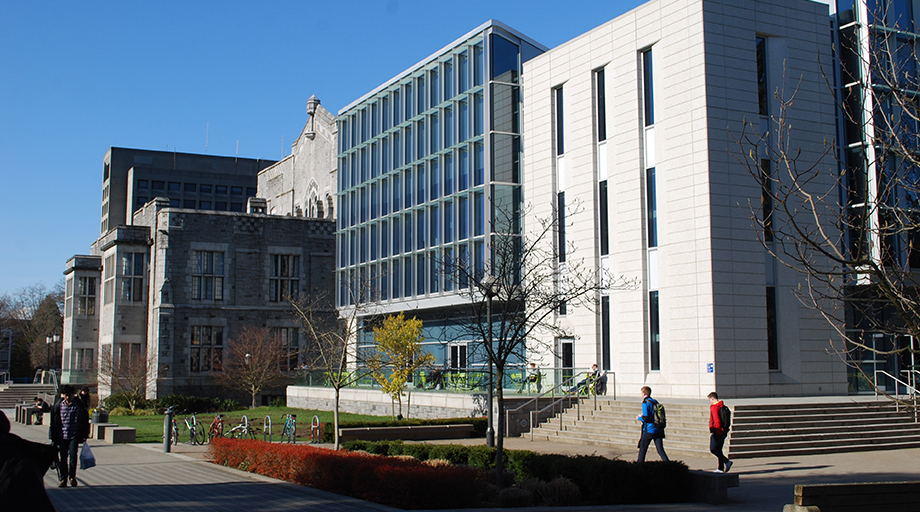This blog post is part of RBSC’s blog series spotlighting items in the Phil Lind Klondike Gold Rush Collection and the Wallace B. and Madeline H. Chung Collection.

Mar June, center to the direct right of man in light suit. Mar Yee Why to the left of the light suit. Ma Wah Kan, on the far left by himself.
Yucho Chow Studio. 1915. “Quon On Jan Travel Agency, Maw Sun Hay – Owner.” Chung Collection. CC-PH-00425. B&W Photograph on matting. doi:http://dx.doi.org/10.14288/1.0216673.
In this photo by Yucho Chow dating to the 1920s we see a group of sharp businessmen in front of the Quon On Jan company store. This photo shows more than just a snapshot of daily life in bygone days – this place was not just a business, but a lifeline for Chinese Canadians navigating immigration, trade, and community life. In this blog we will talk about some of the identified men in this photo and their lives in the context of the Quon On business. This company, alongside its affiliate Quon On Co., was instrumental in the maritime and railway travel networks linking British Columbia to Asia and the United States. At the helm of Quon On Jan was Mar June 馬駿 (centre, farthest on the right), also known by the name 馬心喜—a powerful merchant.
From Ow Ben, Toisan to East Pender Street

Earliest known photo of Mar June, C. 1905. US National Archives and Records Administration. Mar June, Chinese Exclusion Case Files. Box 341 Case 7027/70
Mar June’s origins trace back to the village of Ow Ben, Toisan (歐邊), in Kwonghoi township (廣海) Canton Province. His entry into Canada was recorded as May 1, 1895 on some documents, aligning with a later registration in 1909 upon arrival in Victoria from Seattle aboard the Canadian Pacific SS Princess Victoria. In that 1895 ledger he was listed as a merchant, aged 31, with no head tax recorded—a hint that he may have actually entered and become established before full enforcement of the Chinese Immigration Act. In US National Archives materials, there is ample evidence he travelled between Seattle, Port Townsend, Victoria, and Vancouver often during the years before the 1923 Canadian Exclusion Act was passed.[i]
By 1923, Mar June’s Quon On Jan firm was operating at 137-139 E Pender Street, sharing space with the Ma Gim Doo Hung (馬金紫堂 Mah Family Society). He most likely had a major role purchasing this plot of land and establishing the Mah clan’s hall on this prominent stretch of Chinatown’s commercial thoroughfare when they moved from a rooming house on Cambie St in 1920. This building remains a prominent historical landmark and continues to host the Mah Society of Vancouver. By 1924-1925 Quon On Jan moved to the address shown in the Yucho photo, 295 E Pender.

Detail from an ad and steamship timetable. The Chinese Times [Tai hon Kong Bo Ltd 大漢公報]. 民國十一年九月二十五日 [Sept 25 1922], Chinese Freemasons of Canada [加拿大洪門致公堂] Volume 21, No. 51. Pg. 8
By this period had also established himself as a Chinese Agent for the
Blue Funnel Line—a role he had filled in Vancouver since at least 1914, according to early issues of the
Chinese Times. This company was an rival to the Canadian Pacific Steamships; ticket agents representing Blue Funnel often were competing with the prominent
Yip Family which represented Canadian Pacific. He likely assumed the Blue Funnel portfolio after Lee Kee, roughly parallel to prominent merchant
Seto More who gained the title of Canadian Pacific Chinese agent from the Yips. Additionally, he represented the
Canadian National Railways and the
Admiral Line, a subsidiary of the Pacific Steamship Company that operated from 1918 to 1936. This latter business likely puts him in direct contact with his relation
Harry Mar Dong, a subject of a previous blog.

Mar June in the 1920s or 1930s. US National Archives and Records Administration. Mar June, Chinese Exclusion Case Files. Box 341 Case 7027/70
A Brotherhood of Agents and Merchants
Quon On Jan was not an isolated operation. The wider Mah family and their associates formed a tightly knit web of clan, trade, business, and community roles.
Mar Chan (馬進 also known as Mar Kok Leu/Len, not pictured in the Chow photo), from Kwonghoi, was an elder among Chinese ticket agents in Victoria. Likely a mentor of Mar June, he had arrived in Victoria before the head tax via San Francisco, and as early as 1898 he was a longstanding cannery labor contractor. Like with the Yip family, power and money from Chinese ticketing developed alongside control over where indebted labourers worked through perilous contracts, especially in canneries and farms. Eventually Mar Chan became the head of all Chinese agents for the Blue Funnel Line through both Quon On Co. and Quon On Jan. His business firm and family compound at 529 Cormorant Street, Victoria became a key address used by many Chinese workers registering under the Exclusion Act. He retired to China, his gold mountain dream, in 1928 at the age of 80, after 57 years in Canada. His departure would align with a new generation of brokers, ticket agents, merchants and translators arriving at the forefront of Chinatown life.[ii]

Mar Chan retiring to China. Mar Chan AKA Mar Kok Yen “Records of Entry and Other Records” 1928-06-06/1930-09-11, Microfilm, Canadian Immigration Service, RG 76, T-16586, Image134, CI 9 #053730, Library and Archives Canada.
One of these up-and-comers was Mar Yee Why 馬余槐/淮 (centre, second from left of the four), possibly a cousin or associate of Mar June. Known later as Fred Bing Yee, he arrived in 1918 on the CPR Empress of Japan and began work as a passenger agent for Quon On Co., frequently traveling between Victoria and Vancouver. He journeyed to Seattle throughout the harsh Exclusion era in his private car, connected to Quon On’s operations. His comparative ease of travel across this rigid border often hostile to Chinese is noteworthy; Yee even returned from China in 1933 aboard the SS Ixion in second class—a rarity for Chinese Canadians, but fitting for someone deeply involved in international travel logistics.[iii] He later served as an accountant for the Young Fong Co. and passed away in 1963, survived by his wife, two sons, and a daughter.
The Rise of a Power Couple: Frank Mah and Mary Lam
As the 1930s approached, Frank Mah Fook Shung 馬福崇 emerged as a vital figure in the evolution of Quon On. He married Mary Lam, the daughter of Chung Ling Lam of the Hong Wo store in Richmond, in 1931. Around this point the Quon On partnership dissolved, with Quon On Co. of Victoria and Vancouver continuing as Blue Funnel Agents under Frank’s management, while Quon On Jan became American Mail Line and Dollar Line Agents, with Mar June remaining CNR ticketing agent.

Us National Archives and Records Administration. Frank Mah Fook Shung. Chinese Exclusion Case Files. Box 341 Case 7027/91
Initially the couple lived above Quon On Co.’s new address at 254½ Pender St, but later moved to the Cumberland Apartments on 14th Ave, making the couple early Chinese Canadian residents of Vancouver’s West Side, contemporaries of Tong Louie and Geraldine Seto in Point Grey. The Mah’s became known for their hospitality, hosting dignitaries and leaders of Chinatown as key parts of Vancouver “society life.”

Mary Lam Travelling to the US with her husband. Us National Archives and Records Administration. Frank Mah Fook Shung. Chinese Exclusion Case Files. Box 341 Case 7027/91
Frank was the English Secretary of the Chinese Merchants Association and a prolific presence in the English newspapers of the time. He coordinated the mass exodus of poor Chinese elderly “bachelor” men post-repeal of the Chinese Exclusion Act in 1947. Quon On’s reputation had remained strong into the post-war period, with the firm acting as agent for American President Lines, one of the only lines Chinese Canadians who wished to return to China for retirement could take home—particularly as CPR limited its passenger service from BC.

Frank Mah, centre beneath the Republic of China flag with unidentified Chinese woman. Detail from Soroptomist club of Vancouver [Chinese Appreciation Dinner] RBSC-ARC-1679-CC-PH-11023, Chung Collection, 24 Feb. 1942. B&W Photograph
After Frank’s untimely death in 1948, Mary Lam took over the business and transformed it. As
Mary Mah (or often in newspapers as Mrs. Frank Mah), she became a travel entrepreneur, Chinese art collector, and a cultural ambassador of sorts. Quon On under her direction eventually rebranded as
Quon On Travel Service, representing
Canadian Pacific Air and arranging luxurious global tours. In 1959, for example, she offered a 38-day Pacific Orient travel package visiting Hawaii, Vietnam, Cambodia, Thailand, Malaysia, Japan, and Hong Kong for $1,795, with a discounted rate for companions.
[iv]
A Cultural Legacy
Mary Mah was much more than a travel agent. She was a member of the Soroptimists Club, active in the Pender Y, and taught Cantonese cooking at UBC’s Home Economics building as part of extension courses. She was a supporter of the Chinatown News magazine through her frequent purchase of advertisement space, and was a noteworthy bridge between early local born Chinese and those following in the 1940s and 1950s. These efforts helped broaden understanding and appreciation of Chinese culture in British Columbia during the 1960s.[v] She lectured widely on art, politics, and the cosmopolitan life of Hong Kong.
In 1960, Quon On Co. found itself peripherally involved in the RCMP’s sweeping investigations into “paper sons.” While the company did not engage in document fraud, it occasionally referred inquiries about getting fake documents to George Lim, Mary’s brother and head of Hong Wo store, which managed farms and cannery contracts.[vi]
The Final Chapter
Though Quon On World Travel—the company’s last iteration—likely ended operation during the COVID-19 pandemic, the spirit of the original firm endures. Its legacy lives on through archives, oral histories, and the memories of thousands whose journeys it helped facilitate—across oceans and generations.
Mary Mah passed away on October 21, 1990, just shy of her 90th birthday. She and Frank Mah are buried at Mountain View Cemetery, as well as Mar June and his wife Jung Shee, whose work through businesses like Quon On shaped the Chinese Canadian experience.[vii]

City of Vancouver Planning Department, [438-440 Main Street – Quon On Co. Ltd. Travel and Alexander Beauty Salon], July 1976, COV-S644-: CVA 1095-13756, Box F19-E-02 folder 7. B&W Photo Negative. Copyright City of Vancouver.
Footnotes
[i] US National Archives and Records Administration, Seattle branch. Mar June. Chinese Exclusion Act Case files, Box 341 Case 7027/70.
[ii] Mar Chan had at least three children, and likely had multiple wives as many merchants did. Known descendants are: Mar Kai Kong 馬啓, Mar Kai Kai Leong 馬啓亮, and Mar Hang So.
[iii] Library and Archives Canada, Passenger Lists: Vancouver and Victoria 1925-1935, Reel T-14903, June 3 1933, SS. Ixion
[iv] Chinatown News, Jan 18, 1959, page 11
[v] Chinatown News, Sept 3 1961, page 24
[vi] Library and Archives Canada, 2025, Access to Information Request A-2022-04779, Image 1190
[vii] Frank and Mary Mah had no children, and its unclear if Mar June and his wife or wives did.































